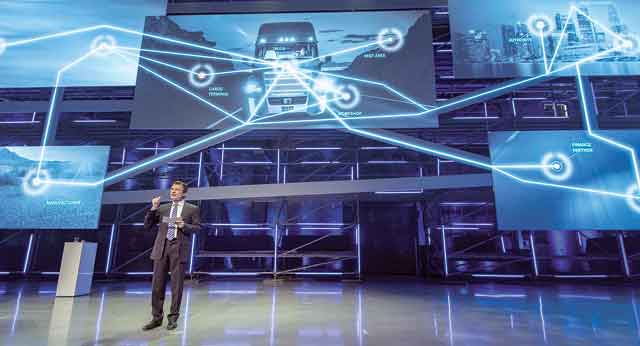Analysis: Trucks Make Everyone Smarter in Bernhard’s Connected Vision
 Bernhard by Daimler AG
Bernhard by Daimler AGThis story appears in the March 28 print edition of Transport Topics.
DÜSSELDORF, Germany — Wolfgang Bernhard, the head of Daimler AG’s global truck and bus unit, said the connected truck — beyond being a benefit to the entire supply chain — offers technology that leads to a “happy driver.”
As connected trucks, such as autonomous platoons, travel the highway, it should be able to analyze real-time conditions, monitor on-duty driving time and signal the location of rest stops along the route, he said. Once the right location is picked, the truck could then make reservations — a parking space for itself and perhaps a dinner reservation for the driver.
Bernhard spoke March 21 at an event here that focused on connectivity and featured a demonstration of a three-truck autonomous platoon on a stretch of the famed autobahn (see main story).
PHOTO GALLERY: Scenes from Dusseldorf
MORE VIDEO FROM DAIMLER: Platooning demo | Emergency braking demo | Lane change demo
While he was addressing more than 300 journalists and other guests from 36 countries. I received an e-mail from the American Transportation Research Institute announcing that it was launching a research initiative to collect information on truckers’ daily challenges finding safe parking.
Though just a coincidence, it was a reminder of the challenges truckers have the world over. In the United States, a parking shortage is eating into the productivity of today’s truck drivers, who are in even shorter supply than parking spaces. The driver shortage was No. 3 on ATRI’s list of industry issues for 2015, and parking was No. 5.
Bernhard acknowledged his vision may never be fully realized but that he strives to see a truck become a round-the-clock operation.
“A truck is a machine that could potentially run 24 hours a day, but our analysis shows on average a truck spends only one-third of its time driving — the rest is waiting,” he said. “It has to wait to get loaded or unloaded. It has to wait at a cargo terminal, at a plant, at the workshop, at customs, at the rest area because the driver needs to sleep.”
While a true 24/7 truck may not be plausible, a more likely idea from Bernhard is the truck informing a logistics provider it is empty after a delivery or still has space available after the next pickup. The provider could then offer the capacity on a load-share system, similar to Uber.
Among other benefits of the connected truck outlined by Bernhard were:
• Speeding deliveries by eliminating paperwork and automatically sending digital information.
• Automatically providing shippers with transit information and photos showing proof of delivery.
• Electronically transmitting customs documents and toll information.
• Speeding repairs by announcing problems before they happen, and quite often, fixing them through software updates.
• Avoiding congestion through real-time traffic data and GPS information.
• Changing insurance rates so they are more directly tied to an individual driver’s performance.
• “Flash over the air” updates to remotely add horsepower when needed or automatically adjust other engine settings.
“So far, the connections of this network are sketchy, sometimes they barely exist,” Bernhard said. “Because the flow of real-time information is weak, the consequence is a waste of resources.”
It has not been uncommon to hear skepticism about autonomous and/or platooning trucks when talking with others about Transport Topics’ experiences, which include events with several OEMs on two continents.
The majority of these questions, revolving around legal implications, public acceptance, cybersecurity and legislation, raise many critical issues. Concerns about training drivers and overall cost are additional factors often cited for the skepticism.
It has been 20 months since an autonomous-driving truck became a reality, and less than 11 months since the Freightliner Inspiration truck event at the Hoover Dam launched the idea into the general U.S. consciousness alongside Google’s self-driving car.
With a platooning challenge including six European truck makers scheduled to begin this week, and similar testing expected in the United States this year involving Peloton Technologies, development of the connected truck is only accelerating.
During my test drive in an autonomous platooning truck, Martin Zeilinger, Daimler’s director of advanced engineering, pointed out that studies on test tracks show drivers who are involved in tasks such as using a tablet during automated driving show 20% better awareness after a 4½-hour shift than manually driving.
“It is worth thinking about which additional [business] tasks a driver can tackle to be in better shape than monotonous driving over long stretches,” he said.
That piece of advice could prove worthwhile in just a matter of years.




